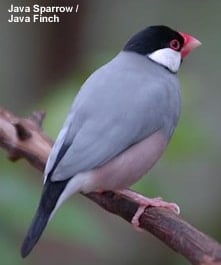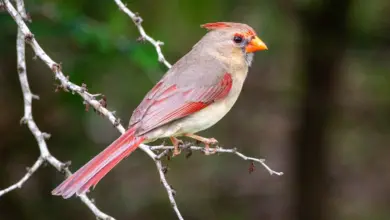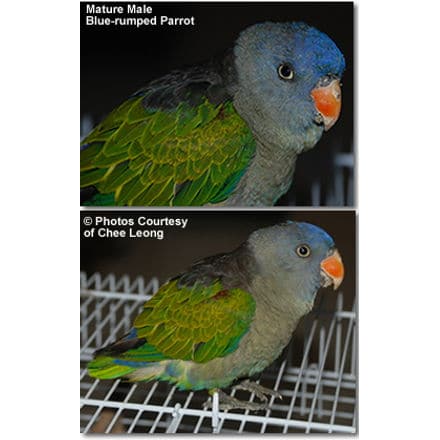Java Finches, Java Rice Finches, Java Temple Birds, Java Sparrows, Paddy Finches
The Java Finches, Padda oryzivora also known as Java Sparrow is a popular cagebird and has been introduced in a large number of other countries.
This small finch is native to Java, Bali, and Bawean. It frequents open grassland and cultivations and was formerly a pest in rice fields, hence its scientific name. The nest is constructed in a tree or building, and each clutch contains up to eight eggs.
The call is a chip, and the song is a rapid series of call notes chipchipchipchipchipchip.

The photos and information are courtesy of Mandy and Paul – Breeder of Canaries and Other Exotic Birds – Singing Wings Aviary – www.singing-wings-aviary.com (A great source for these beautiful little finches)
Description:
In the normal form the head, nape, and chin are black with white cheek patches outlined in black. The primary flight wing feathers and upper tail converts are also black. A blue-gray covers the bird’s mantle, back, secondary wings, chest, and rump. The belly is a cinnamon brown color and the under tail coverts are white. Javas have red-pink beaks, legs, and eye circles. Both sexes look identical with only slight differences in beak shape and color.
Size:
These birds average 5-6 inches (13-15cm) and are very hardy birds.
Sexing Javas:
Sexing a Java Finch is the hardest part of owning one. It can be very difficult to have sex, especially with young birds! There are four ways to distinguish the gender of Java Finches but only one has 100% accuracy so let’s start there.
ONLY the male Java Finch sings!! Young male birds will attempt to sing at about 1-2 months after they fledge.
In order to hear the bird sing you can separate them from all other birds. If the bird in question is a male it will start to sing after about a week of solitude.
If you have a flight full of Javas it will be easier to pick out males because they sing a lot more in a flight or you can try introducing a new Java into the flight to entice the males.
The Java Finches problem with spotting them in the flight is catching the same bird that was singing!!
To solve this you can put a different color plastic band on all your Javas and when you hear one singing notice it’s band color. You can write this down in your records, catch the birds up later, and band all the hens one color and the males another.
There are other ways to sex Javas such as beak sexing (please refer to photos below), eyering sexing, pelvis sexing, and DNA sexing.
When sexing by beak it is important to note that mature male Javas have a swollen area at the base of the beak and hens do not. The hen’s beak seems longer and narrower in comparison while the male’s beak is wider and has a blunt tip.
Below are some really good photos taken from Rob Salem and myself which illustrate what I am trying to explain.
After taking a look at the photos, the differences in the beaks become much more apparent and of course, after time with a trained eye, it is easier to pick out males.
Just remember the base of a young male’s beak is not nearly as swollen as a mature male’s beak but it is still wider and blunter than the hen’s beak.

Further Finch Reading
- Finch Information
- Index of Finch Species
- Photos of the Different Finch Species for Identification
- Common Health Problems of Finches
- Finch / Canary Diet / Nutrition
Beauty Of Birds strives to maintain accurate and up-to-date information; however, mistakes do happen. If you would like to correct or update any of the information, please contact us. THANK YOU!!!



